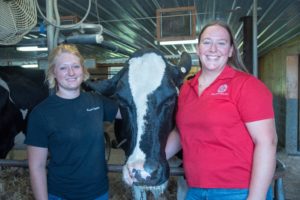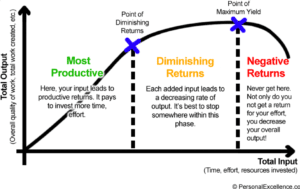The Law of Diminishing Returns – How Farms Know When They’ve Reached It
By Betsy Hicks, South Central New York Dairy & Field Crops
Today’s economy has every producer struggling to find ways to increase cash flow. We fill stalls, add a few more cows, keep plentiful heifers in the pipeline, and estimate
our projected inventory of first calf heifers due to calve and add it to the count of cows in our milking string. Banks, profit teams, nutritionists, owners, veterinarians, managers – everyone looks at these numbers. Adding more cows lets us extrapolate out numbers of projections of what milk could look like and potentially positively impact cash flow. We know feed costs, we know how long it takes us to milk extra cows; we put numbers to things to define what these extra cows can do to our bottom line.
But at what point does putting an extra cow in the barn starts to yield negative results? Yes, milk per stall may look great, but what strain or stress has it put on the entire system? With fresh cow groups, or close-up dry groups, we know exactly how many cows we can put in the group before we start seeing metabolic issues. With heifers, though, are we able to define exactly what those negatives are? And what about the added strain on the human element? If you have narrow alley ways, slippery floors in the summertime and more cows in a group than before, what does that do for the efficiency of the worker? How about the worker’s state of mind while trying to sift through that group of cows?
When we overcrowd the system, yes, we’re trying to be as productive as possible – filling the barn to capacity will pretty much always yield more cash flow than a barn that’s half full. Pushing the limits leads us to the law of diminishing returns – we put another cow in the group, but instead of the average of the group being 80 lbs/cow, now it’s 78 or 77. Still positive, being that we added more milk, but not quite as high as we were before. We overcrowd that fresh cow group and blow up with ketosis and DA’s– that’s the point of negative returns, not a fun or profitable place to be.
So, let’s think about these points in our system and how we can relate it back to results. Yes, we need to cash flow, but more animals aren’t always the answer. I challenge you to look at each point in your system and identify where you are past the point of getting a positive return. If we were making $24 conventional milk again, I have a feeling that a lot of transition heifer barns would be going up to correct a huge overcrowding issue in our replacement program. Again, though, more animals isn’t always the answer. To relieve crowding, we can either put animals in a bigger space, or we can remove animals from the space. New barns aren’t in the cards that dairy producers are holding right now, so removing animals from the space is the next best answer. Do you know how many heifers you need to maintain your herd size or maintain growth for expansion? Odds are, with the results in reproductive efficiency that I see on many herds today, we don’t need to keep a 1:1 ratio of heifers to cows – probably 80% of the cow herd is realistic, even with a herd in expansion mode.
If you only keep 80% though, that means some heifers have to leave! I challenge herds all the time – what are the criteria for deciding if that heifer gets to stay? This needs to be decided BEFORE the calf hits the ground. Many times, I’ve seen half beef breeds running around in heifer pens because the producer decided to use beef semen as a way to either get a problem cow pregnant or to convince themselves that they don’t want to keep the genetics from the cow, and they didn’t sell the calf afterwards. In either scenario, the producer needs to make a management decision AHEAD OF TIME. Every herd has a bottom third of cows. This is a good place to start making decisions about who to keep.
What happens when we start maximizing our system instead of overtaxing our system? We have less milk to have to feed – or the capacity to feed more milk to fewer calves and maximize growth. Letting a few calves leave the farm immediately may open up opportunities to starting weighing heifers at specific time points to reveal gaps in performance that can be addressed. We have less crowded heifer pens – or healthier calves that don’t have underlying respiratory disease and have reached puberty faster. We have heifers that reach the milking string more quickly – or heifers of the proper size calving in that start to pay you back sooner. With the milking string, we have cows calving in that have no metabolic issues and reach consistently high peak milks. We have time to not just trim cows that need attention, but do maintenance trims on the whole herd. We have ample bedding in stalls and cleaner pens for cows to spend their day in. From the human aspect, taking care of healthy cows and calves is far less stressful than caring for the poor performers in the group.
Making these management decisions doesn’t happen overnight, and can be overwhelming. Having the conversation with your nutritionist, veterinarian and/or extension educator is a great place to start.
Implementing your strategy will be hard, but knowing that taking a proactive approach to managing herd size will only benefit your dairy in the years to come.
Betsy Hicks is a dairy specialist with the Cornell Cooperative Extension South Central New York Dairy & Field Crops team



